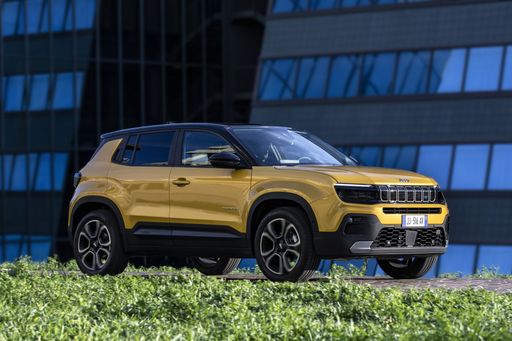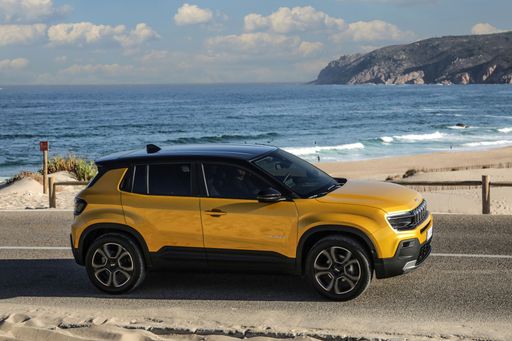When it comes to the SUV segment, few brands evoke the same level of passion and performance as Alfa Romeo and Jeep. In this comparison, we delve into the characteristics of the Alfa Romeo Junior and the Jeep Avenger, examining their technical specifications, innovations, and how they stack up against each other in a rapidly evolving automotive landscape.
Alfa Romeo Junior vs Jeep Avenger – Which model is better for everyday use?
Everyday use, family trips or long-distance drives – here’s where the differences show.
Discover whether Alfa Romeo Junior or Jeep Avenger fits your lifestyle better.
Design and Dimensions
Both the Alfa Romeo Junior and the Jeep Avenger embrace modern SUV styling, featuring bold lines and an athletic stance. The Junior, with a length of 4173 mm, width of 1781 mm, and height of 1533 mm, offers a slightly larger footprint compared to the Avenger, which measures in at 4084 mm in length, 1776 mm in width, and ranges from 1528 mm to 1536 mm in height. This size difference translates into a notably spacious trunk capacity in the Junior, boasting 400 to 415 liters, compared to the Avenger’s 355 to 380 liters.
Performance and Powertrain
In terms of power, both models are equipped with a range of engines. The Junior is offered with an efficient petrol MHEV and fully electric drivetrain options, providing power outputs ranging from 136 HP to 280 HP. The competitive Jeep Avenger mirrors these offerings, with its petrol MHEV and electric options also delivering 156 HP. The Junior’s electric range impresses, reaching up to 410 km, while the Avenger matches closely with a range of 400 km. Both vehicles cater well to environmentally conscious drivers, achieving zero emissions in their electric formats.
Fuel Efficiency and Emissions
When we look at consumption figures, the Junior showcases an impressive efficiency rating of 4.5 L/100 km in its petrol configuration and 15.2 kWh/100 km in electric mode, while the Avenger slightly trails with 5.7 L/100 km and 15.4 kWh/100 km. Regarding CO2 emissions, the Junior excels with a classification of A, emitting up to 103 g/km, while the Avenger’s emissions vary, with some models classified under C and D.
Driving Dynamics
Acceleration is a significant metric, and here the Junior clearly demonstrates its dynamic capabilities. The range of acceleration from 0-100 km/h spans from a brisk 5.9 seconds up to 9 seconds, providing a thrilling driving experience. The Avenger, while proficient, has a slightly slower range, from 9 to 10.9 seconds, depending on the variant. Both models come with a front-wheel-drive layout, ensuring competent road handling and stability.
Innovations and Technology
In terms of technological advancements, the Alfa Romeo Junior integrates modern driving assistance systems and an intuitive infotainment setup tailored for seamless connectivity. Meanwhile, the Jeep Avenger is equipped with advanced off-road technology, reflective of its heritage, providing drivers with versatile capabilities for a range of terrains and conditions.
Conclusion: Which SUV Reigns Supreme?
Ultimately, the choice between the Alfa Romeo Junior and the Jeep Avenger will boil down to personal preferences and intended use. The Junior shines with its powerful lineup, elegant design, and electric efficiency, catering to urban dwellers and performance enthusiasts alike. Conversely, the Avenger pulls ahead in rugged versatility and brand heritage, appealing to those seeking an adventurous spirit. Both models are worthy contenders in the SUV market, each with its unique strengths and innovative features.
Here’s where it gets real: The technical differences in detail
Costs and Efficiency:
Price and efficiency are often the first things buyers look at. Here it becomes clear which model has the long-term edge – whether at the pump, the plug, or in purchase price.
Jeep Avenger has a a bit advantage in terms of price – it starts at 21900 £, while the Alfa Romeo Junior costs 25700 £. That’s a price difference of around 3729 £.
Fuel consumption also shows a difference: Alfa Romeo Junior manages with 4.80 L and is therefore barely noticeable more efficient than the Jeep Avenger with 4.90 L. The difference is about 0.10 L per 100 km.
In terms of energy consumption, the advantage goes to the Alfa Romeo Junior: with 15.10 kWh per 100 km, it’s barely noticeable more efficient than the Jeep Avenger with 15.50 kWh. That’s a difference of about 0.40 kWh.
As for range, the Alfa Romeo Junior performs slight better – achieving up to 410 km, about 10 km more than the Jeep Avenger.
Engine and Performance:
Under the bonnet, it becomes clear which model is tuned for sportiness and which one takes the lead when you hit the accelerator.
When it comes to engine power, the Alfa Romeo Junior has a significantly edge – offering 280 HP compared to 156 HP. That’s roughly 124 HP more horsepower.
In acceleration from 0 to 100 km/h, the Alfa Romeo Junior is decisively quicker – completing the sprint in 5.90 s, while the Jeep Avenger takes 9 s. That’s about 3.10 s faster.
In terms of top speed, the Alfa Romeo Junior performs barely noticeable better – reaching 206 km/h, while the Jeep Avenger tops out at 194 km/h. The difference is around 12 km/h.
There’s also a difference in torque: Alfa Romeo Junior pulls evident stronger with 345 Nm compared to 260 Nm. That’s about 85 Nm difference.
Space and Everyday Use:
Cabin size, boot volume and payload all play a role in everyday practicality. Here, comfort and flexibility make the difference.
Both vehicles offer seating for 5 people.
In curb weight, Jeep Avenger is slightly lighter – 1180 kg compared to 1380 kg. The difference is around 200 kg.
In terms of boot space, the Alfa Romeo Junior offers slight more room – 415 L compared to 380 L. That’s a difference of about 35 L.
In maximum load capacity, the Alfa Romeo Junior performs barely noticeable better – up to 1280 L, which is about 3 L more than the Jeep Avenger.
When it comes to payload, Jeep Avenger somewhat takes the win – 502 kg compared to 420 kg. That’s a difference of about 82 kg.
Who comes out on top?
Overall, the Alfa Romeo Junior shows itself to be is largely superior and secures the title of DriveDuel Champion.
It convinces with the more balanced overall package and proves to be the more versatile choice for everyday use.
 @ Alfa Romeo / Stellantis Media
@ Alfa Romeo / Stellantis Media
Alfa Romeo Junior
Alfa Romeo Junior
The Alfa Romeo Junior captures the essence of Italian design with its sleek lines and compact dimensions, making it an icon of elegance and performance. With a spirited driving experience and a charming retro aesthetic, it appeals to enthusiasts and casual drivers alike. This delightful car embodies the brand's rich heritage while remaining a fun and engaging option for those seeking a unique automotive experience.
details @ Alfa Romeo / Stellantis Media
@ Alfa Romeo / Stellantis Media
 @ Alfa Romeo / Stellantis Media
@ Alfa Romeo / Stellantis Media
 @ Alfa Romeo / Stellantis Media
@ Alfa Romeo / Stellantis Media
Jeep Avenger
The Jeep Avenger is a compact SUV that brings a blend of rugged design and modern technology, making it ideal for both urban and off-road adventures. Its robust build and distinctive styling capture Jeep's iconic spirit while offering a comfortable and refined driving experience. With advanced safety features and a versatile interior, the Avenger caters to a wide range of drivers looking for practicality and excitement.
details @ Jeep / Stellantis Media
@ Jeep / Stellantis Media
 @ Jeep / Stellantis Media
@ Jeep / Stellantis Media
 @ Jeep / Stellantis Media
@ Jeep / Stellantis Media
 @ Jeep / Stellantis Media
@ Jeep / Stellantis Media
 @ Jeep / Stellantis Media
@ Jeep / Stellantis Media
 @ Alfa Romeo / Stellantis Media
@ Alfa Romeo / Stellantis Media
|
 @ Jeep / Stellantis Media
@ Jeep / Stellantis Media
|
|
|
|
Costs and Consumption |
|
|---|---|
|
Price
25700 - 41600 £
|
Price
21900 - 36900 £
|
|
Consumption L/100km
4.8 - 5.4 L
|
Consumption L/100km
4.9 - 5.7 L
|
|
Consumption kWh/100km
15.1 - 17.5 kWh
|
Consumption kWh/100km
15.50 kWh
|
|
Electric Range
344 - 410 km
|
Electric Range
400 km
|
|
Battery Capacity
0.4 - 51 kWh
|
Battery Capacity
51 kWh
|
|
co2
0 - 119 g/km
|
co2
0 - 129 g/km
|
|
Fuel tank capacity
44 - 45 L
|
Fuel tank capacity
44 L
|
Dimensions and Body |
|
|---|---|
|
Body Type
SUV
|
Body Type
SUV
|
|
Seats
5
|
Seats
5
|
|
Doors
5
|
Doors
5
|
|
Curb weight
1380 - 1689 kg
|
Curb weight
1180 - 1520 kg
|
|
Trunk capacity
340 - 415 L
|
Trunk capacity
325 - 380 L
|
|
Length
4173 mm
|
Length
4084 - 4088 mm
|
|
Width
1781 mm
|
Width
1776 mm
|
|
Height
1505 - 1538 mm
|
Height
1527 - 1541 mm
|
|
Max trunk capacity
1205 - 1280 L
|
Max trunk capacity
1218 - 1277 L
|
|
Payload
390 - 420 kg
|
Payload
494 - 502 kg
|
Engine and Performance |
|
|---|---|
|
Engine Type
Electric, Petrol MHEV
|
Engine Type
Electric, Petrol, Petrol MHEV
|
|
Transmission
Automatic
|
Transmission
Automatic, Manuel
|
|
Transmission Detail
Dual-Clutch Automatic, Reduction Gearbox
|
Transmission Detail
Reduction Gearbox, Manual Gearbox, Dual-Clutch Automatic
|
|
Drive Type
Front-Wheel Drive, All-Wheel Drive
|
Drive Type
Front-Wheel Drive, All-Wheel Drive
|
|
Power HP
136 - 280 HP
|
Power HP
100 - 156 HP
|
|
Acceleration 0-100km/h
5.9 - 9.1 s
|
Acceleration 0-100km/h
9 - 10.6 s
|
|
Max Speed
150 - 206 km/h
|
Max Speed
150 - 194 km/h
|
|
Torque
230 - 345 Nm
|
Torque
205 - 260 Nm
|
|
Number of Cylinders
3
|
Number of Cylinders
3
|
|
Power kW
100 - 207 kW
|
Power kW
74 - 115 kW
|
|
Engine capacity
1199 cm3
|
Engine capacity
1199 cm3
|
General |
|
|---|---|
|
Model Year
2024 - 2025
|
Model Year
2023 - 2025
|
|
CO2 Efficiency Class
A, C, D
|
CO2 Efficiency Class
A, D, C
|
|
Brand
Alfa Romeo
|
Brand
Jeep
|
What drive types are available for the Alfa Romeo Junior?
Available configurations include Front-Wheel Drive or All-Wheel Drive.
The prices and data displayed are estimates based on German list prices and may vary by country. This information is not legally binding.
